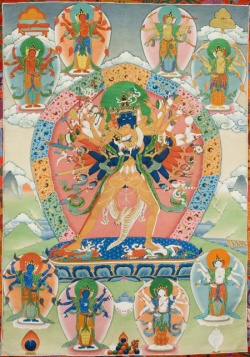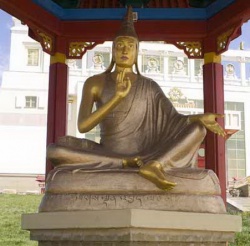Difference between revisions of "Phowa"
(Created page with "'''Phowa''' (Wylie: 'pho ba; also spelled Powa or Poa phonetically; Sanskrit:''' saṃkrānti''') is a Vajrayāna Buddhist meditation practice. It may be described as "the pra...") |
|||
| (14 intermediate revisions by 3 users not shown) | |||
| Line 1: | Line 1: | ||
| − | + | [[Image:Amitabha.jpg|thumb|250px||[[Amitabha]])]<nomobile>{{DisplayImages|2575|1117|1096}}</nomobile> | |
| − | |||
| − | |||
| − | |||
| − | |||
| − | + | '''[[Phowa]]''' (Skt. ''[[saṃkrānti]]''; Tib. {{BigTibetan|[[འཕོ་བ་]]}}; [[Wyl.]] ''[[‘pho ba]]'') is the [[practice]] for directing the [[transference of consciousness]] at the time of [[death]], either for oneself or another. | |
| − | |||
| − | + | [[Phowa]] ([[Tibetan]]: {{BigTibetan|[[འཕོ་བ]]}}, [[Wylie]]: [['pho ba]], [[Sanskrit]]: [[saṃkrānti]]) is a [[Vajrayana]] [[Buddhist meditation practice]]. It may be described as "the [[practice of conscious dying]]", "[[transference of consciousness]] at the time of [[death]]", "[[mindstream transference]]", or “[[enlightenment without meditation]]” ([[Wylie]]: [[ma-sgom sangs-rgyas]]). "This controversial [[esoteric]] technique (Skt.utkrānti), by which a [[tantric practitioner]] is able to sever his [[connection]] to the [[physical body]], goes by the [[Indian]] reference to '[[yogic]]' or [[spiritual]] [[suicide]] | |
| − | The | + | The [[consciousness]] may be transferred to the [[dharmakaya]] [[nature]], to a [[pure realm]] such as [[Sukhavati]] or to a [[favourable]] [[existence]] in the [[human realm]]. |
| − | + | The [[practice]] is one of the [[Six Yogas of Naropa]], but is also to be found in many other [[lineages]] and systems of [[teaching]], [[including]] the [[Longchen Nyingtik]] and [[Namchö]] cycles. | |
| − | + | Although it is included among the so-called '[[five practices of enlightenment without meditation]], it does require a thorough {{Wiki|training}} before it can be put into effect successfully. | |
| − | + | Moreover, the teachings advise that [[phowa]] for others should only be undertaken by someone who has reached the [[path of seeing]]. | |
| − | ::Phowa has many different meanings; in Tibetan it means "transferring consciousness." The highest form is known as the phowa of the dharmakaya which is meditation on the great perfection. When you do Dzogchen | + | |
| − | {{ | + | ==Subdivisions== |
| − | [[Category: | + | |
| + | |||
| + | [[Tsele Natsok Rangdrol]] lists [[five kinds of phowa]]: | ||
| + | |||
| + | {| class="wikitable" style="color:black;background-color:#f7f7e7;" cellspacing="5" border="0" text-align:left,top" | ||
| + | |+ | ||
| + | |valign="top"| | ||
| + | #[[dharmakaya]] [[transference]] free from focus (''[[chos sku gtad med kyi 'pho ba]]'') | ||
| + | #[[sambhogakaya]] [[transference]] of {{Wiki|unity}} (''[[longs sku zung 'jug gi 'pho ba]]'') | ||
| + | #[[nirmanakaya]] [[transference]] of {{Wiki|training}} (''[[sprul sku rtsal sbyong gi 'pho ba]]'') | ||
| + | #[[guru]]'s [[transference]] of [[blessings]] (''[[byin rlabs bla ma'i 'pho ba]]'') | ||
| + | #unmistaken ''[[khachö]]'' [[transference]] ('''[[chugs med mkha' spyod kyi 'pho ba]]'')<ref>Tsele notes that this is the same as 'finding relief in a natural [[nirmanakaya]] [[pure realm]]', as spoken of in the [[Dzogchen]] teachings</ref> | ||
| + | |valign="top"| | ||
| + | ::{{BigTibetan|༈ [[ཆོས་སྐུ་གཏད་མེད་ཀྱི་འཕོ་བ།]]}}<br> | ||
| + | ::{{BigTibetan|[[ལོངས་སྐུ་ཟུང་འཇུག་གི་འཕོ་བ།]]}}<br> | ||
| + | ::{{BigTibetan|[[སྤྲུལ་སྐུ་རྩལ་སྦྱོང་གི་འཕོ་བ།]]}}<br> | ||
| + | ::{{BigTibetan|[[བྱིན་རླབས་བླ་མའི་འཕོ་བ།]]}}<br> | ||
| + | ::{{BigTibetan|[[འཆུགས་མེད་མཁའ་སྤྱོད་ཀྱི་འཕོ་བ།]]}}<br> | ||
| + | |} | ||
| + | |||
| + | [[Patrul Rinpoche]] mentions another list of [[five kinds of phowa]]: | ||
| + | |||
| + | #{{Wiki|Superior}} [[transference]] to the [[dharmakaya]] through the {{Wiki|seal}} of the view | ||
| + | #Middling [[transference]] to the [[sambhogakaya]] through the union of the [[generation and completion]] phases | ||
| + | #Lesser [[transference]] to the [[nirmanakaya]] through [[immeasurable]] [[compassion]] | ||
| + | #Ordinary “[[phowa]] of three recognitions”: {{Wiki|recognition}} of our [[central channel]] as the [[path]]; {{Wiki|recognition}} of our [[consciousness]] as the traveller; and {{Wiki|recognition}} of the {{Wiki|environment}} of a [[buddha realm]] as the destination. | ||
| + | #[[Transference]] performed for the [[dead]] with the hook of [[compassion]] | ||
| + | |||
| + | |||
| + | In the [[Dzogchen]] teachings, two kinds of [[transference]] are sometimes mentioned: | ||
| + | |||
| + | |||
| + | {| class="wikitable" style="color:black;background-color:#f7f7e7;" cellspacing="5" border="0" text-align:left,top" | ||
| + | |+ | ||
| + | |valign="top"| | ||
| + | #[[transference]] of entering the [[sphere of clear light]] (Tib. ''[[ösal bub juk gi phowa]]''; [[Wyl.]] ''[['od gsal sbubs 'jug gi 'pho ba]]'')<ref>Also translated as 'entering the '''interior''' of [[clear light]]'. | ||
| + | |||
| + | See ''[[Zindri]]'', p. 282</ref> | ||
| + | |||
| + | #[[transference of consciousness]] riding the [[subtle energy]] (Tib. ''[[namshé lung shyön gyi phowa]]''; [[Wyl.]] ''[[rnam shes rlung zhon gyi 'pho ba]]'') | ||
| + | |valign="top"| | ||
| + | ::{{BigTibetan|༈ [[འོད་གསལ་སྦུབས་འཇུག་གི་འཕོ་བ]]།}} | ||
| + | ::{{BigTibetan|[[རྣམ་ཤེས་རླུང་ཞོན་གྱི་འཕོ་བ།]]}}<br> | ||
| + | |} | ||
| + | |||
| + | {{reflist}} | ||
| + | |||
| + | |||
| + | ==Further Reading== | ||
| + | |||
| + | |||
| + | {{Nolinking|*[[Chagdud Khadro]], ''[[P’howa]] Commentary'', [[Pilgrims Publishing]], [[India]], 2004 | ||
| + | *[[Sogyal Rinpoche]], ''[[The Tibetan Book of Living and Dying]]'', Ch. 13 & 14.}} | ||
| + | |||
| + | {{RigpaWiki}} | ||
| + | {{NewSourceBreak}} | ||
| + | |||
| + | [[File:Phowa.jpg|thumb|250px|]] | ||
| + | '''[[Phowa]]''' ([[Wylie]]: '[[pho ba]]; also spelled [[Powa]] or [[Poa]] {{Wiki|phonetically}}; [[Sanskrit]]:''' [[saṃkrānti]]''') is a [[Vajrayāna]] | ||
| + | |||
| + | |||
| + | [[Buddhist meditation]] [[practice]]. | ||
| + | |||
| + | |||
| + | It may be described as "the [[practice of conscious dying]]", "[[transference of consciousness]] at the time of [[death]]", "[[mindstream transference]]", or “[[enlightenment without meditation]]” ([[Wylie]]: [[ma-sgom sangs-rgyas]]). | ||
| + | |||
| + | |||
| + | ==Application of [[Phowa]]== | ||
| + | |||
| + | |||
| + | The method can be applied at the [[moment of death]] to [[transfer one's consciousness through the top of the head directly into a Buddha-field]] of one’s choice. | ||
| + | |||
| + | By so doing, one bypasses some of the typical [[experiences]] that are said to occur after [[death]]. | ||
| + | |||
| + | Example destinations are [[Sukhāvatī]], [[Abhirati]], [[Ghanavyūha]], [[Aṭakāvatī]], Mount [[Potala]], the [[Copper-Colored Mountain]] ([[Wylie]]: | ||
| + | |||
| + | [[Zangs-mdog dpal-ri]]), and [[Tuṣita]]; the most popular is [[Sukhavati]]. | ||
| + | |||
| + | [[Phowa]] is also performed by specialists ([[Wylie]]: [[’pho-’debs bla-ma]]) on the behalf of the deceased, as a [[post-mortem]] [[ritual]]. | ||
| + | |||
| + | |||
| + | ==[[Mark of Phowa practice]]== | ||
| + | |||
| + | |||
| + | The mark of a successful [[Phowa]] [[practice]] is a [[small drop of blood directly from the center of the vertex]]. | ||
| + | |||
| + | To demonstrate a successful [[practice]] [[traditionally]] a [[Kusha-grass]] was pushed into the small opening created in the fontanel. | ||
| + | |||
| + | |||
| + | ==[[Lineages]]== | ||
| + | |||
| + | |||
| + | The main [[lineage of phowa]] is one of the [[Six yogas of Naropa]], although other [[transmissions]] also [[exist]]. | ||
| + | |||
| + | The [[chöd]] subsumes within its {{Wiki|auspices}} aspects of [[phowa sadhana]]. | ||
| + | |||
| + | |||
| + | The [[Kagyu phowa lineage]] is from the [[Six yogas of Naropa]]. | ||
| + | |||
| + | [[Nāropa]] received it from the [[Indian]] [[mahāsiddha]] [[Tilopa]] and later passed it to his [[Tibetan disciple] Marpa]]. | ||
| + | |||
| + | [[Nāropa’s]] teachings describe a second method of ’[[pho-ba]] that entails the [[transference of one’s consciousness to another body]] ([[Wylie]]: [[’pho-ba grong-’jug]]). | ||
| + | |||
| + | |||
| + | [[Milarepa’s]] query regarding these teachings forced [[Marpa]] to search for explanatory treatises on the [[subject]] among his [[Indian]] [[manuscripts]], and, having found none, to return to [[India]] to obtain more [[scriptures]]. | ||
| + | |||
| + | |||
| + | The [[Drikung Kagyu]] school of [[Tibetan Buddhism]] is known for their [[phowa]] teachings. | ||
| + | |||
| + | A major [[pilgrimage]] and {{Wiki|cultural}} celebration is known in the [[Tibetan]] [[world]] as the [[Great Drikung Phowa]] ([[Wylie]]: [[’Bri-gung ’pho-ba chen-mo]]). | ||
| + | |||
| + | |||
| + | This {{Wiki|festival}} was [[traditionally]] held once in every [[twelve-year calendrical cycle]], and its last [[observance]] took place in August 1992 in [[gTer-sgrom]], {{Wiki|Central Tibet}}, after a hiatus of 36 years due to a ban enforced by the {{Wiki|Chinese}} authorities. | ||
| + | |||
| + | [[Choeje Ayang Rinpoche]] from [[Eastern Tibet]] belongs to the [[Drikung]] school and is an authority on [[Buddhist afterlife rituals]]; he gives teachings and [[initiations]] to the [[practice of phowa]] annually in [[Bodh Gaya]], [[India]]. | ||
| + | |||
| + | Some [[lineages of [phowa]] include a [[rite]] of incision, or opening of the [[sahasrara]] at the cranial [[zenith]], to assist with transferral. | ||
| + | |||
| + | |||
| + | ==In [[Dzogchen]]== | ||
| + | |||
| + | |||
| + | [[Shugchang]], et al., in an {{Wiki|exegesis}} of the [[Zhitro]], discuss [[phowa]] in [[Dzogchen]] has many different meanings; in [[Tibetan]] it means "[[transferring consciousness]]." | ||
| + | |||
| + | The [[highest]] [[form]] is known as the [[phowa of the dharmakaya]] which is [[meditation on the great perfection]]. | ||
| + | |||
| + | When you do [[Dzogchen meditations]] no need to transfer anything, because there's [[nothing]] to transfer, no place to transfer it, nor anyone to do it. | ||
| + | |||
| + | That's the [[highest]], and greatest [[phowa practice]]. | ||
| + | |||
| + | |||
| + | |||
| + | {{E}} | ||
| + | [[Category:Phowa]] | ||
| + | [[Category:Bardo]] | ||
| + | [[Category:Vajrayana]] | ||
| + | [[Category:Death & Rebirth]] | ||
| + | [[Category:Buddhist Terms]] | ||
| + | [[Category:Tibetan Buddhism]] | ||
Latest revision as of 12:45, 3 August 2022
[[Image:Amitabha.jpg|thumb|250px||Amitabha)]
Phowa (Skt. saṃkrānti; Tib. འཕོ་བ་; Wyl. ‘pho ba) is the practice for directing the transference of consciousness at the time of death, either for oneself or another.
Phowa (Tibetan: འཕོ་བ, Wylie: 'pho ba, Sanskrit: saṃkrānti) is a Vajrayana Buddhist meditation practice. It may be described as "the practice of conscious dying", "transference of consciousness at the time of death", "mindstream transference", or “enlightenment without meditation” (Wylie: ma-sgom sangs-rgyas). "This controversial esoteric technique (Skt.utkrānti), by which a tantric practitioner is able to sever his connection to the physical body, goes by the Indian reference to 'yogic' or spiritual suicide
The consciousness may be transferred to the dharmakaya nature, to a pure realm such as Sukhavati or to a favourable existence in the human realm.
The practice is one of the Six Yogas of Naropa, but is also to be found in many other lineages and systems of teaching, including the Longchen Nyingtik and Namchö cycles.
Although it is included among the so-called 'five practices of enlightenment without meditation, it does require a thorough training before it can be put into effect successfully.
Moreover, the teachings advise that phowa for others should only be undertaken by someone who has reached the path of seeing.
Subdivisions
Tsele Natsok Rangdrol lists five kinds of phowa:
Patrul Rinpoche mentions another list of five kinds of phowa:
- Superior transference to the dharmakaya through the seal of the view
- Middling transference to the sambhogakaya through the union of the generation and completion phases
- Lesser transference to the nirmanakaya through immeasurable compassion
- Ordinary “phowa of three recognitions”: recognition of our central channel as the path; recognition of our consciousness as the traveller; and recognition of the environment of a buddha realm as the destination.
- Transference performed for the dead with the hook of compassion
In the Dzogchen teachings, two kinds of transference are sometimes mentioned:
|
Footnotes
- ↑ Tsele notes that this is the same as 'finding relief in a natural nirmanakaya pure realm', as spoken of in the Dzogchen teachings
- ↑ Also translated as 'entering the interior of clear light'. See Zindri, p. 282
Further Reading
- Chagdud Khadro, P’howa Commentary, Pilgrims Publishing, India, 2004
- Sogyal Rinpoche, The Tibetan Book of Living and Dying, Ch. 13 & 14.
Source
Phowa (Wylie: 'pho ba; also spelled Powa or Poa phonetically; Sanskrit: saṃkrānti) is a Vajrayāna
It may be described as "the practice of conscious dying", "transference of consciousness at the time of death", "mindstream transference", or “enlightenment without meditation” (Wylie: ma-sgom sangs-rgyas).
Application of Phowa
The method can be applied at the moment of death to transfer one's consciousness through the top of the head directly into a Buddha-field of one’s choice.
By so doing, one bypasses some of the typical experiences that are said to occur after death.
Example destinations are Sukhāvatī, Abhirati, Ghanavyūha, Aṭakāvatī, Mount Potala, the Copper-Colored Mountain (Wylie:
Zangs-mdog dpal-ri), and Tuṣita; the most popular is Sukhavati.
Phowa is also performed by specialists (Wylie: ’pho-’debs bla-ma) on the behalf of the deceased, as a post-mortem ritual.
Mark of Phowa practice
The mark of a successful Phowa practice is a small drop of blood directly from the center of the vertex.
To demonstrate a successful practice traditionally a Kusha-grass was pushed into the small opening created in the fontanel.
Lineages
The main lineage of phowa is one of the Six yogas of Naropa, although other transmissions also exist.
The chöd subsumes within its auspices aspects of phowa sadhana.
The Kagyu phowa lineage is from the Six yogas of Naropa.
Nāropa received it from the Indian mahāsiddha Tilopa and later passed it to his [[Tibetan disciple] Marpa]].
Nāropa’s teachings describe a second method of ’pho-ba that entails the transference of one’s consciousness to another body (Wylie: ’pho-ba grong-’jug).
Milarepa’s query regarding these teachings forced Marpa to search for explanatory treatises on the subject among his Indian manuscripts, and, having found none, to return to India to obtain more scriptures.
The Drikung Kagyu school of Tibetan Buddhism is known for their phowa teachings.
A major pilgrimage and cultural celebration is known in the Tibetan world as the Great Drikung Phowa (Wylie: ’Bri-gung ’pho-ba chen-mo).
This festival was traditionally held once in every twelve-year calendrical cycle, and its last observance took place in August 1992 in gTer-sgrom, Central Tibet, after a hiatus of 36 years due to a ban enforced by the Chinese authorities.
Choeje Ayang Rinpoche from Eastern Tibet belongs to the Drikung school and is an authority on Buddhist afterlife rituals; he gives teachings and initiations to the practice of phowa annually in Bodh Gaya, India.
Some [[lineages of [phowa]] include a rite of incision, or opening of the sahasrara at the cranial zenith, to assist with transferral.
In Dzogchen
Shugchang, et al., in an exegesis of the Zhitro, discuss phowa in Dzogchen has many different meanings; in Tibetan it means "transferring consciousness."
The highest form is known as the phowa of the dharmakaya which is meditation on the great perfection.
When you do Dzogchen meditations no need to transfer anything, because there's nothing to transfer, no place to transfer it, nor anyone to do it.
That's the highest, and greatest phowa practice.



